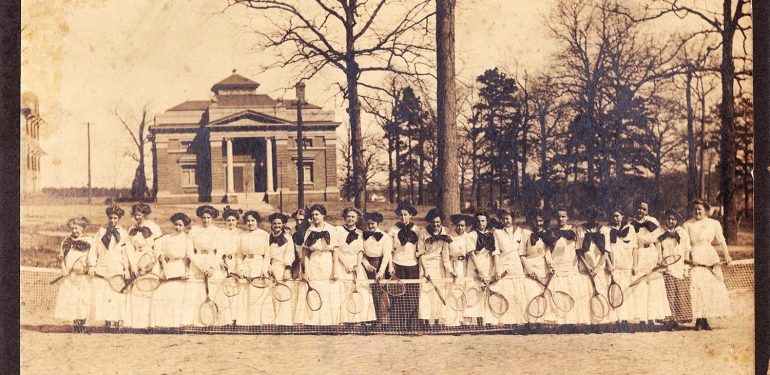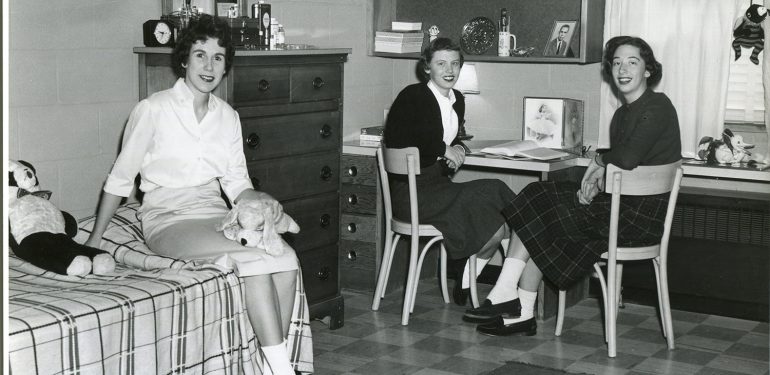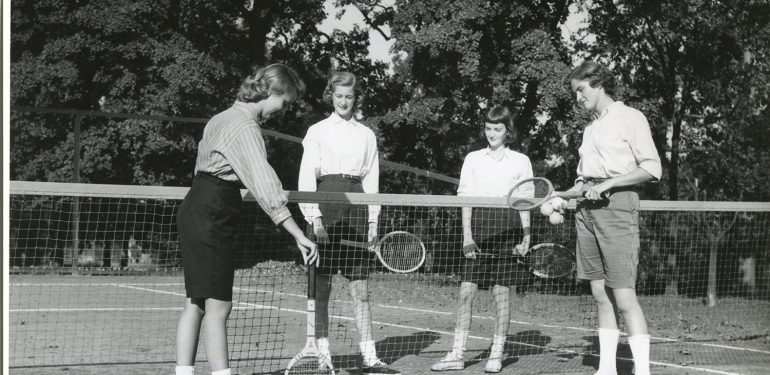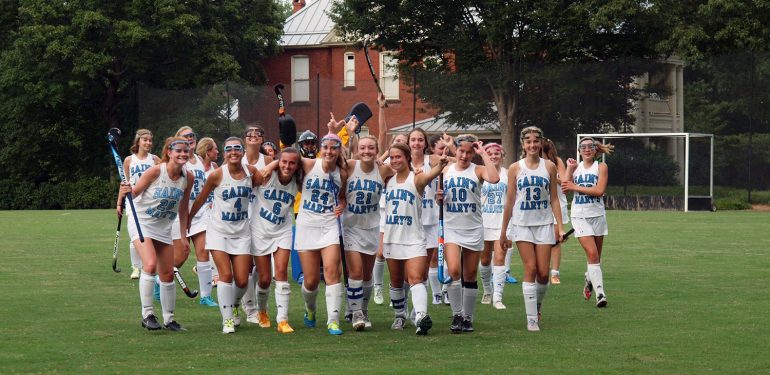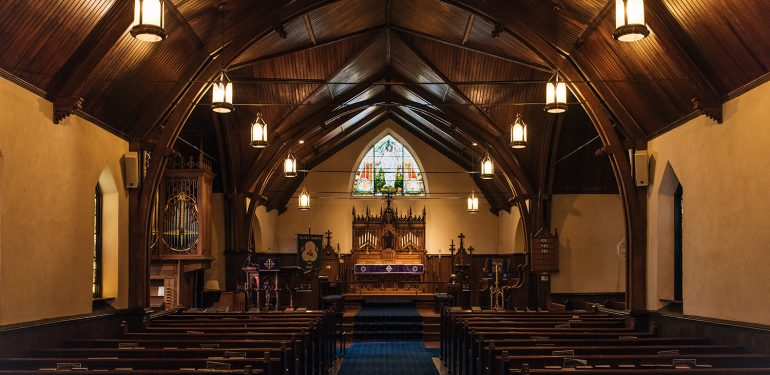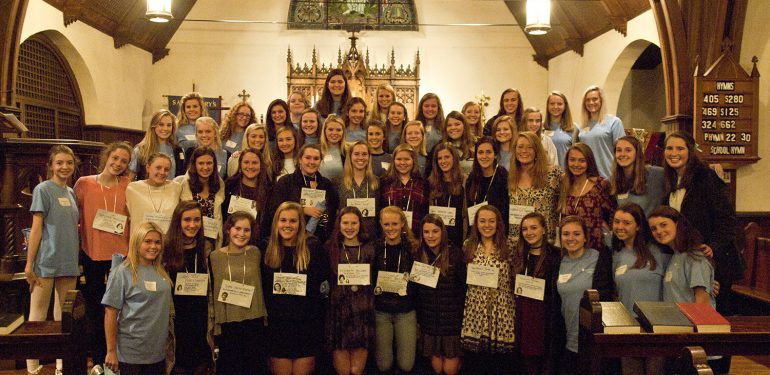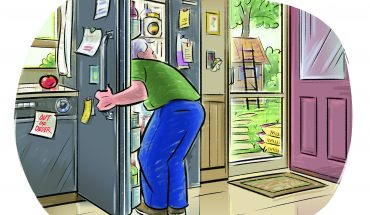St. Mary’s School at 175
Raleigh’s oldest continually operated school celebrates a major milestone.
by Hampton Williams Hofer
photographs by Jillian Clark
[archival photographs courtesy of St. Mary’s School]
On May 12, Saint Mary’s School, the nation’s second oldest Episcopal girls’ school, will celebrate 175 years of educating young women on its historic campus in downtown Raleigh.
In the school’s main building is a parlor where General Tecumseh Sherman once had tea with the school’s founder, the Reverend Aldert Smedes. That room is now WiFi-accessible, scattered with girls leaning over their school-issued convertible laptop tablets. On the same front steps where tuition was once bartered for bales of cotton and sacks of flour amid the strain of wartime, girls now cluster in field hockey uniforms, chatting and listening to music.
The story of Saint Mary’s, Raleigh’s oldest continually operating school, is one of resilience and adaptation. The school has not only survived but thrived, thanks to its ability to change with the times, instituted on the ideals of Aldert Smedes. Some 78 years before women could vote, he boldly asserted that “an educated woman can make a difference in society.
At times serving girls from kindergarten all the way through junior college, Saint Mary’s is now a high school, comprised of 270 students from ten states and five countries. It’s like many high schools, where a student can take AP calculus and join the photography club and get revved up about spirit week and prom. However, Saint Mary’s is different from most high schools, and not just because the dining hall offers options like roasted vegetable quiche for breakfast. Saint Mary’s has a college-like 24/7 campus where girls – boarders and day-students alike – are encouraged to engross themselves in extracurricular activities, stay for dinner, and use the library at night – a library that is stocked with more than 39,000 catalogued holdings.
Students at Saint Mary’s have nontraditional academic options like an independent study program, individual instrumental lessons, and exchanges to Australia and France. A few weeks ago, the school’s Exploratorium was full of girls learning to code. Still, the school remains rooted in a storied history, a legacy that runs deeper than the foundations of its central buildings, which were built with stones left over from the construction of the North Carolina State Capitol, eight blocks away.
The original 13
It all started with the originals. Thirteen girls arrived in the Saint Mary’s Grove on May 12, 1842, greeted by the Rev. Smedes. The campus had been the site of a failed boys’ school that went bankrupt after just four years. But Smedes, a New Yorker who had moved south for health reasons, was determined to make a girls’ school flourish there. And he knew what he was doing. He came from a family of strong women, his mother the headmistress of a prestigious girls’ school in Manhattan. When the original thirteen arrived, he opened the doors of Saint Mary’s; they have, amazingly, never closed. Through the Civil War and the World Wars, periods of economic disaster and social upheaval, Saint Mary’s has stood as a place of solace and safety for young women to receive, as Smedes imagined, “a thorough and excellent education equal to the best that can be obtained in the city of New York, or in any Northern school.”
Now situated in the heart of an award-winning public school system, Saint Mary’s stays relevant in part due to its loyal following. The alumnae network includes 10,000 members from all over the world. “I was once on a plane and the woman seated behind me noticed my ring,” recalls Hollan Young (’02), referring to the school’s trademark black onyx school ring that bears the Saint Mary’s seal. “She held up her own hand, both of us proud SMS girls, and we spent the rest of the flight sharing memories.” Nearly a quarter of Saint Mary’s students are members of the Granddaughters Club, reserved for direct descendants of alumnae. This devotion to the school has created a healthy endowment, insuring a bright future for Saint Mary’s (the annual fund goal is $1.5 million for this year alone). And the legacy is not all about women. Former Raleigh mayor Smedes York is the great-great-grandson of the school’s founder: “I’m proud to have his name,” York says. “Our family will always be supportive of Saint Mary’s – my wife attended the school, and my grandmother was born there. It’s all especially gratifying in that Saint Mary’s is flourishing in its 175th year.”
Saint Mary’s girls are prepared for college and life at an institution that has continually acclimated to changing times – ditching the dress code, for one. Kaye Livermore (’61) remembers an old sign from the school’s early years that was left up in her dormitory reminding students not to leave the building without a hat and a corset, something even the girls in the late ’50s found comical. Today, with no uniforms and no boys, the Saint Mary’s campus has a lot of pajama pants and un-brushed hair. But that, for many students and their parents, is one of the greatest perks of single-sex education: “I feel free to voice my opinions because I know that I’m in a safe environment and that I won’t be judged. I definitely feel that it’s because there aren’t boys,” says junior Lucy Glover.
Certainly some students lament their ability to have the sorts of relationships they see on TV, but ultimately, the single-sex setting is essential to the Saint Mary’s mission. “In the all-girls environment, there is no mold for what a teenage girl should be,” says mathematics teacher and ninth grade dorm head Rachel Hencher. “Our students come from many walks of life, cultures, and have vastly different interests. Here, they are presented with the challenge to simply be themselves.”
More than half of Saint Mary’s students board, which the school encourages. One of its best arguments for boarding is Raleigh. Brimming with culture and situated nicely between the ocean and the mountains, Raleigh allures students from all over the world, and ensures that girls who live at Saint Mary’s do not get bored on the weekends. Each Wednesday, a list of the weekend’s activities is posted; students can sign up for things like hiking at Umstead Park or shopping at Cameron Village. Gloria Becker (class of ’92 and the vice-chair of the board of trustees) spent her high school years boarding at Saint Mary’s and recalls a lively, festive atmosphere: “Living with hundreds of girls, it was always someone’s birthday, or a sports victory, or someone getting asked out on a date – we always had a reason to celebrate.” Becker’s hall of girls played cards every evening to finish out the day: “Even Mrs. Selph, our hall mother, would join us. That sense of community and fellowship was instrumental during my high school years.”
Saint Mary’s boasts distinguished alumnae such as Nell Wilson McAdoo, daughter of President Woodrow Wilson and head of Washington’s largest Red Cross auxiliary. The first female speaker pro tempore of the North Carolina House, Marie Colton, graduated from Saint Mary’s, as did Bevin Prince, the actress known for her role on television’s One Tree Hill. Joining these ranks doesn’t come cheap; this year’s tuition and fees are $26,175 for day students and $52,185 for boarders.
Historic surroundings
Of the 25 buildings on campus, five are Raleigh Historic Properties, and all are password protected with modern punch-code doors. East Rock, which was built in 1834, is now the headquarters of the school’s IT Department. But perhaps the most iconic building on campus is the Saint Mary’s Chapel, dark and quiet with intricate stained-glass windows and ancient wooden pews. For more than a century-and-a-half, the Gothic-
revival style chapel has been home to school gatherings, Eucharist services, and alumnae weddings. It was designed by renowned architect Richard Upjohn, and now sits on the National Register of Historic Places. The entire Saint Mary’s community meets there twice a week, with frequent homilies from guest priests and, once a year, the Bishop. Saint Mary’s students, while not pressured toward Christianity, are instead meant to be spiritually intrigued by their time at chapel. For many girls, chapel presents a time of rest, a chance to disconnect from the rigors of academic life.
To be sure, not all alumnae remember chapel time so fondly. Some recall old, strict chaplains delivering lengthy sermons, while the girls waited impatiently to make a mad dash to the dining hall for a good spot in the lunch line. Chicken fajitas, no doubt, weighed more heavily on the minds of some teenagers than the Psalms, but at least in retrospect, alumnae agree that chapel is an important time for perspective: to have the whole school in one room, to see the scope of that community, and to realize that Saint Mary’s is about more than academics. “We love our little white chapel,” says junior Suiter Ragland, “I look around during chapel, watching each advisory swaying to the school hymn, and I know that what we have is unique.”
At the beginning of this school year, a group of student government members planted a red maple tree near the front gate to kick off the school’s celebration of its 175th year, which will culminate with a gala for as many as 1,000 on campus in May. The layered history of Saint Mary’s, for everyone in the school community, means something.
Current students feel a tighter grasp on history by crossing the same grove where Sherman’s Union troops once camped during the Civil War. “You look at this one school that reflects so many past time periods,” says senior Bess Moye. “I walk through Smedes Hall, so much of which has remained the same since the school’s opening, and I realize how far Saint Mary’s has come.” For many students, that legacy is deeply personal. Two of the original thirteen are great-great-great aunts of Gabe Bratton (’05); her father is the chair of the board of trustees. “To me, it was special that the school meant so many things to so many people in my family,” says Bratton, whose wedding reception will be held on campus this fall. “And then I got to have my own Saint Mary’s experience, and it’s something I’m still tying into my life.”

